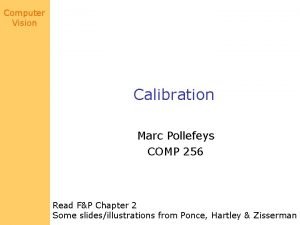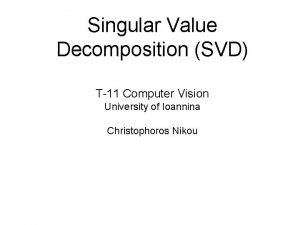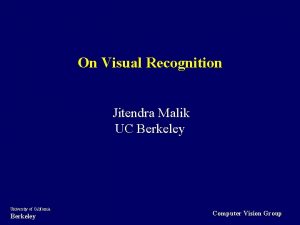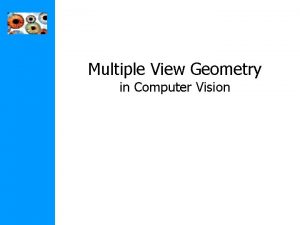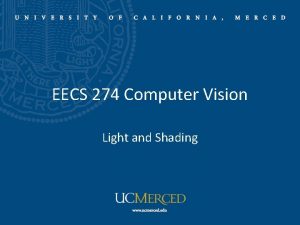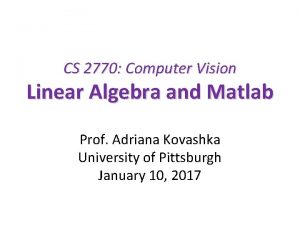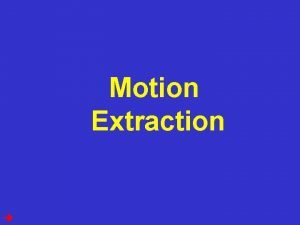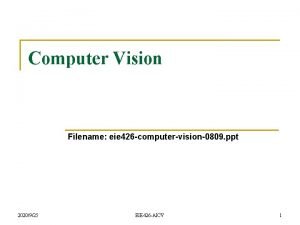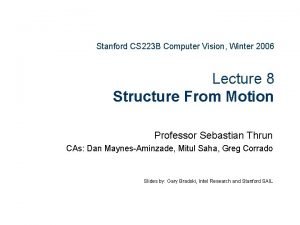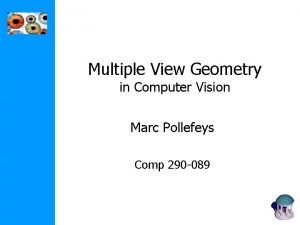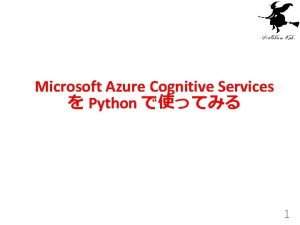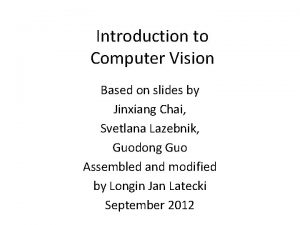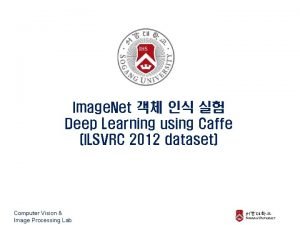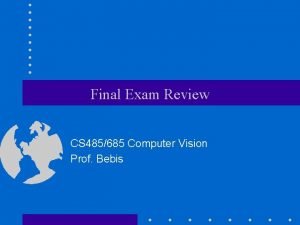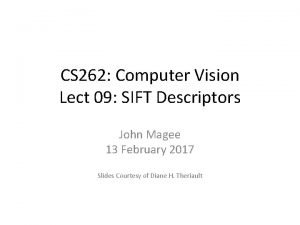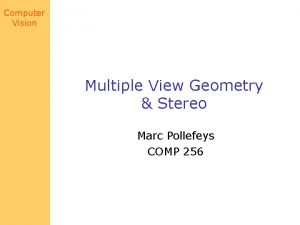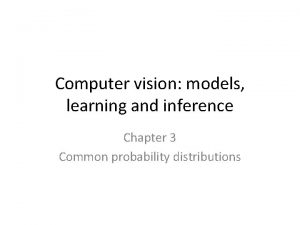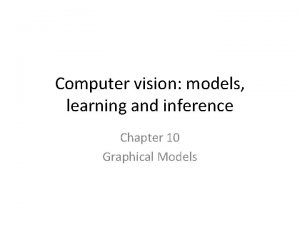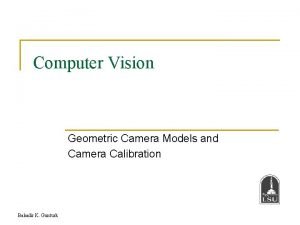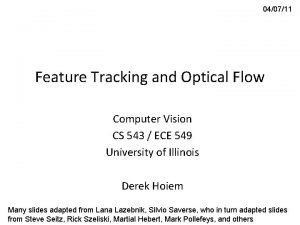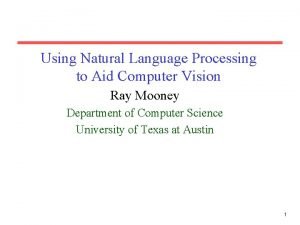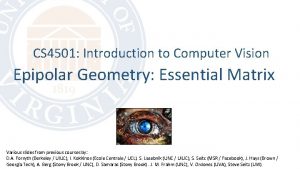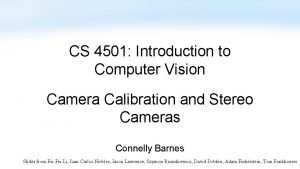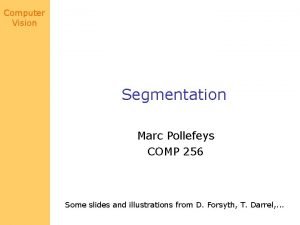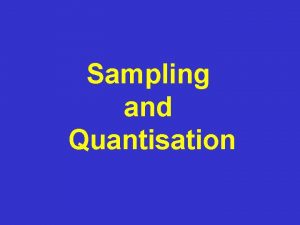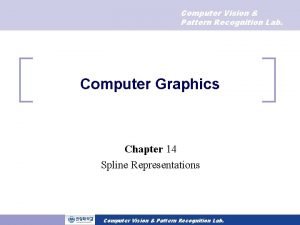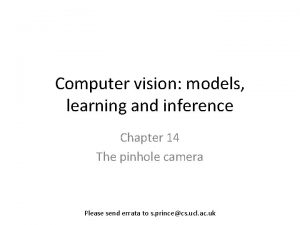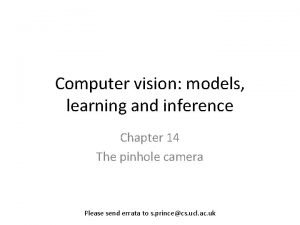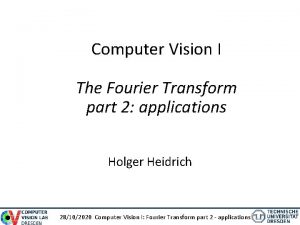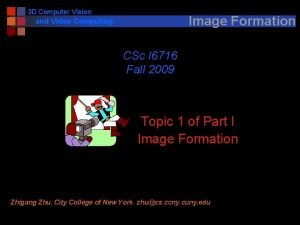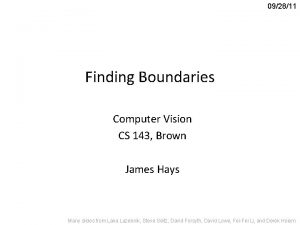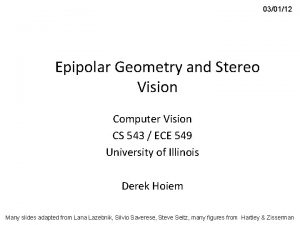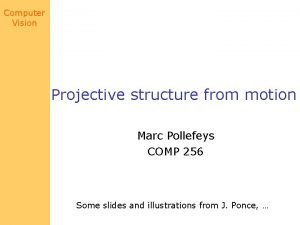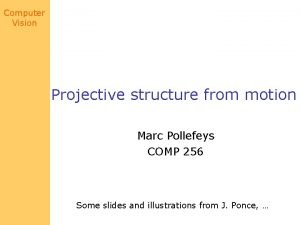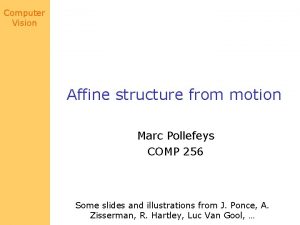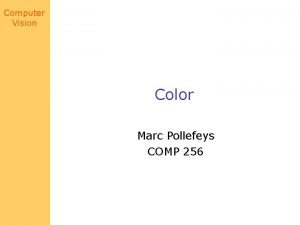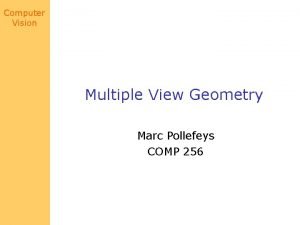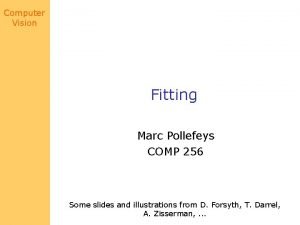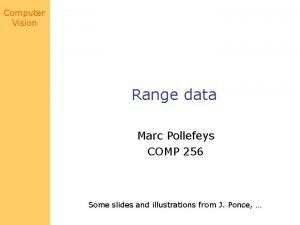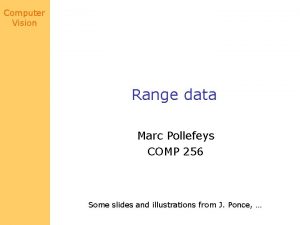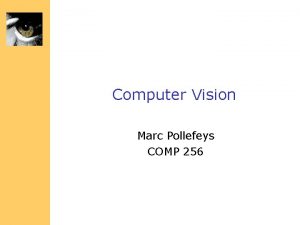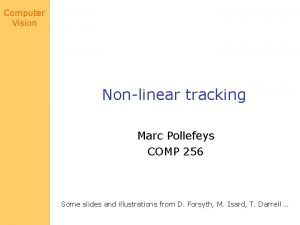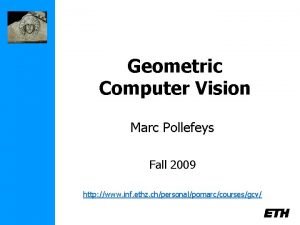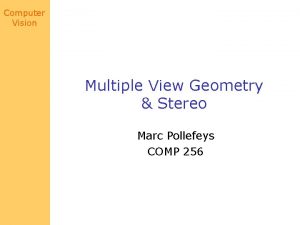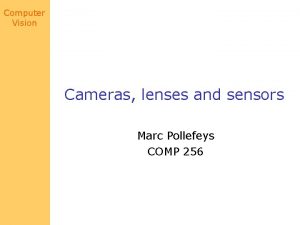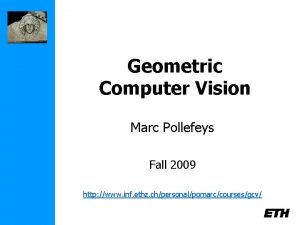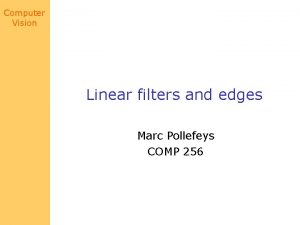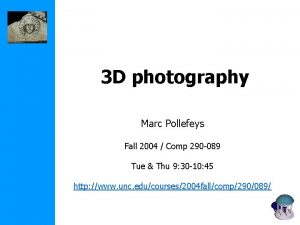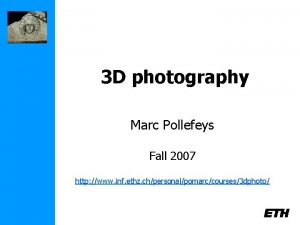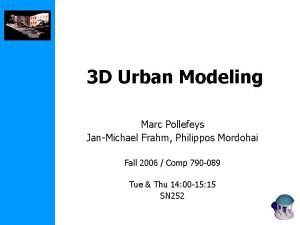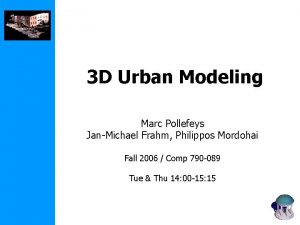Computer Vision Structure from motion Marc Pollefeys COMP



















































- Slides: 51

Computer Vision Structure from motion Marc Pollefeys COMP 256 Some slides and illustrations from J. Ponce, A. Zisserman, R. Hartley, Luc Van Gool, …

Computer Vision Last time: Optical Flow Ix u It Ixu=- It Aperture problem: two solutions: - regularize (smoothness prior) - constant over window (i. e. Lucas-Kanade) Coarse-to-fine, parametric models, etc…

Tentative class schedule Computer Vision Aug 26/28 - Introduction Cameras Radiometry Sources & Shadows Color Sep 16/18 Linear filters & edges (Isabel hurricane) Sep 23/25 Pyramids & Texture Multi-View Geometry Stereo Project proposals Tracking (Welch) Optical flow Oct 14/16 - - Oct 21/23 Silhouettes/carving (Fall break) Oct 28/30 - Structure from motion Project update Camera calibration Nov 11/13 Segmentation Fitting Nov 18/20 Prob. segm. &fit. Matching templates Nov 25/27 Matching relations (Thanksgiving) Range data Final project Sep 2/4 Sep 9/11 Sep 30/Oct 2 Oct 7/9 Nov 4/6 Dec 2/4

Computer Vision Today’s menu • Affine structure from motion – Geometric construction – Factorization • Projective structure from motion – Factorization – Sequential

Computer Vision Affine Structure from Motion Reprinted with permission from “Affine Structure from Motion, ” by J. J. (Koenderink and A. J. Van Doorn, Journal of the Optical Society of America A, 8: 377 -385 (1990). 1990 Optical Society of America. Given m pictures of n points, can we recover • the three-dimensional configuration of these points? • the camera configurations? (structure) (motion)

Computer Vision Orthographic Projection Parallel Projection

Computer Vision Weak-Perspective Projection Paraperspective Projection

Computer Vision The Affine Structure-from-Motion Problem Given m images of n fixedj points P we can write Problem: estimate the m 2 x 4 matrices M iand the n positions P j from the mn correspondences p. ij 2 mn equations in 8 m+3 n unknowns Overconstrained problem, that can be solved using (non-linear) least squares!

Computer Vision The Affine Ambiguity of Affine SFM When the intrinsic and extrinsic parameters are unknown If M i and P are solutions, j So are M’ and P’ where i j and Q is an affine transformation.

Computer Vision Affine Spaces: (Semi-Formal) Definition

Computer Vision 2 Example: R as an Affine Space

Computer Vision In General The notation is justified by the fact that choosing some origin O in X allows us to identify the point P with the vector OP. Warning: P+u and Q-P are defined independently of O!!

Computer Vision Barycentric Combinations • Can we add points? R=P+Q • But, when • Note: NO! we can define

Computer Vision Affine Subspaces

Computer Vision Affine Coordinates • Coordinate system for U: • Coordinate system for Y=O+U: • Affine coordinates: • Coordinate system for Y: • Barycentric coordinates:

Computer Vision When do m+1 points define a p-dimensional subspace Y of an n-dimensional affine space X equipped with some coordinate frame basis? Rank ( D ) = p+1, where Writing that all minors of size (p+2)x(p+2) of D are equal to zero gives the equations of Y.

Computer Vision Affine Transformations Bijections from X to Y that: • Bijections map m-dimensional subspaces of X onto m-dimensional • subspaces map linesofof. Y; X onto lines of Y; and preserve thesubspaces ratios of signed lengthssubspaces; of • • map parallel onto parallel and line segments. • preserve affine (or barycentric) coordinates. 3 In E they are combinations of rigid transformations, nonuniform scalings and shears.

Computer Vision Affine Transformations II • Given two affine spaces X and Y of dimension m, and two coordinate frames (A) and (B) for these spaces, there exists a unique affine transformation mapping (A) onto (B). • Given an affine transformation from X to Y, one can always write: • When coordinate frames have been chosen for X and Y, this translates into:

Computer Vision Affine projections induce affine transformations from planes onto their images.

Computer Vision Affine Shape Two point sets S and S’ in some affine space X are affinely equivalent when there exists an affine transformation y: X X such that X’ = y ( X ). Affine structure from motion = affine shape recovery. = recovery of the corresponding motion equivalence classes.

Computer Vision Geometric affine scene reconstruction from two images (Koenderink and Van Doorn, 1991).

Computer Vision Affine Structure from Motion Reprinted with permission from “Affine Structure from Motion, ” by J. J. (Koenderink and A. J. Van Doorn, Journal of the Optical Society of America A, 8: 377 -385 (1990). 1990 Optical Society of America. (Koenderink and Van Doorn, 1991)

Computer Vision The Affine Epipolar Constraint Note: the epipolar lines are parallel.

Computer Vision Affine Epipolar Geometry

Computer Vision The Affine Fundamental Matrix where

Computer Vision An Affine Trick. . Algebraic Scene Reconstruction

Computer Vision The Affine Structure of Affine Images Suppose we observe a scene with m fixed cameras. . The set of all images of a fixed scene is a 3 D affine space!

Computer Vision has rank 4!

Computer Vision From Affine to Vectorial Structure Idea: pick one of the points (or their center of mass) as the origin.

Computer Vision What if we could factorize D? (Tomasi and Kanade, 1992) Affine SFM is solved! Singular Value Decomposition We can take

Computer Vision From uncalibrated to calibrated cameras Weak-perspective camera: Calibrated camera: Problem: what is Q ? Note: Absolute scale cannot be recovered. The Euclidean shape (defined up to an arbitrary similitude) is recovered.

Reconstruction Computer Vision Results (Tomasi and Kanade, 1992) Reprinted from “Factoring Image Sequences into Shape and Motion, ” by C. Tomasi and T. Kanade, Proc. IEEE Workshop on Visual Motion (1991). 1991 IEEE.

Computer Vision More examples Tomasi Kanade’ 92, Poelman & Kanade’ 94

Computer Vision More examples Tomasi Kanade’ 92, Poelman & Kanade’ 94

Computer Vision More examples Tomasi Kanade’ 92, Poelman & Kanade’ 94

Computer Vision Further Factorization work Factorization with uncertainty (Irani & Anandan, IJCV’ 02) Factorization for indep. moving objects (Costeira and Kanade ‘ 94) Factorization for dynamic objects (Bregler et al. 2000, Brand 2001) Perspective factorization (next week) (Sturm & Triggs 1996, …) Factorization with outliers and missing pts. (Jacobs 1997 (affine), Martinek and Pajdla 2001, Aanaes 2002 (perspective))

Computer Vision Multiple indep. moving objects

Computer Vision Multiple indep. moving objects

Computer Vision Dynamic structure from motion (Bregler et al ’ 00; Brand ‘ 01) Extend factorization approaches to deal with dynamic shapes

Computer Vision Representing dynamic shapes (fig. M. Brand) represent dynamic shape as varying linear combination of basis shapes

Computer Vision Projecting dynamic shapes Rewrite: (figs. M. Brand)

Computer Vision Dynamic image sequences One image: Multiple images (figs. M. Brand)

Computer Vision Dynamic Sf. M factorization? Problem: find J so that M has proper structure

Computer Vision Dynamic Sf. M factorization (Bregler et al ’ 00) Assumption: SVD preserves order and orientation of basis shape components

Computer Vision Results (Bregler et al ’ 00)

Computer Vision Dynamic Sf. M factorization (Brand ’ 01) constraints to be satisfied for M, use to compute J hard! (different methods are possible, not so simple and also not optimal)

Computer Vision Non-rigid 3 D subspace flow (Brand ’ 01) • Same is also possible using optical flow in stead of features, also takes uncertainty into account

Computer Vision Results (Brand ’ 01)

Computer Vision Results (Brand ’ 01)

Computer Vision Results (Bregler et al ’ 01)

Computer Vision Next class: Projective structure from motion
 Marc pollefeys
Marc pollefeys Cs766
Cs766 Basic structure of a computer
Basic structure of a computer Elmore vision motion picture soundtracks love yourself
Elmore vision motion picture soundtracks love yourself What is active rom
What is active rom Simple harmonic motion formula
Simple harmonic motion formula An object in motion stays in motion
An object in motion stays in motion Chapter 2 section 1 describing motion answer key
Chapter 2 section 1 describing motion answer key Describing and measuring motion
Describing and measuring motion Section 1 describing motion
Section 1 describing motion Chapter 1 lesson 1 position and motion answer key
Chapter 1 lesson 1 position and motion answer key Motion section 1 describing motion
Motion section 1 describing motion Cmu 16-385
Cmu 16-385 Kalman filter computer vision
Kalman filter computer vision Svd computer vision
Svd computer vision Berkeley computer vision
Berkeley computer vision Multiple view geometry tutorial
Multiple view geometry tutorial Face detection viola jones
Face detection viola jones Radiometry in computer vision
Radiometry in computer vision Linear algebra for computer vision
Linear algebra for computer vision Impoverished motion examples
Impoverished motion examples Computer vision
Computer vision Watershed segmentation
Watershed segmentation Computer vision stanford
Computer vision stanford Multiple view geometry in computer vision
Multiple view geometry in computer vision Python cognitive services
Python cognitive services Mathematical foundations of computer graphics and vision
Mathematical foundations of computer graphics and vision Computer vision slides
Computer vision slides Caffe computer vision
Caffe computer vision Computer vision final exam
Computer vision final exam Sift computer vision
Sift computer vision Multiple view geometry in computer vision
Multiple view geometry in computer vision Computer vision: models, learning, and inference
Computer vision: models, learning, and inference Computer vision models learning and inference pdf
Computer vision models learning and inference pdf Camera models in computer vision
Camera models in computer vision Aperture problem computer vision
Aperture problem computer vision Computer vision vs nlp
Computer vision vs nlp Epipolar geometry computer vision
Epipolar geometry computer vision Computer vision camera calibration
Computer vision camera calibration Computer vision
Computer vision Sampling in computer vision
Sampling in computer vision Computer vision
Computer vision Computer vision
Computer vision Computer vision
Computer vision Computer vision
Computer vision Fourier transform in computer vision
Fourier transform in computer vision Image formation computer vision
Image formation computer vision Computer vision brown
Computer vision brown Computer vision brown
Computer vision brown Epipolar geometry computer vision
Epipolar geometry computer vision Computer vision brown
Computer vision brown Szeliski computer vision
Szeliski computer vision
